Today was one of those golden days in second grade.
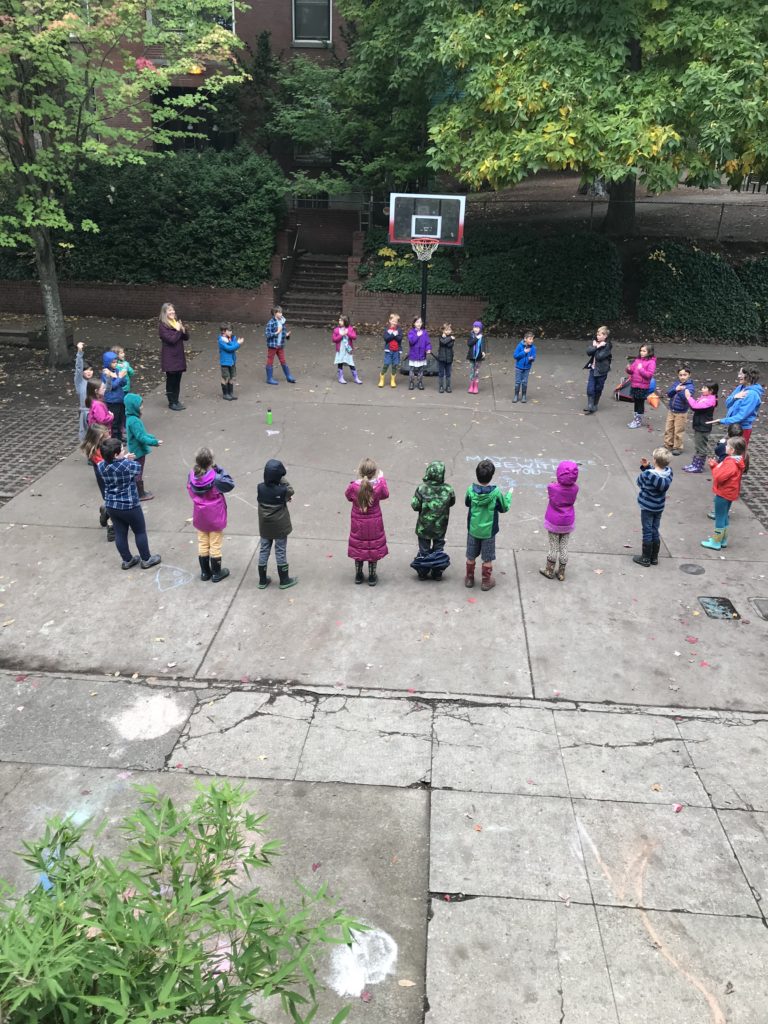
My students were just rowdy enough in our morning jumprope line to make the supporting parents express their appreciation for the cat-herding aspect of my job, but once we came inside, the 2nd graders reminded me why I love being their teacher.
It’s interesting how sometimes all I need to do is notice how well they are doing something and they decide to turn up the charm and do their best to blow me away.
This morning they sang our opening song so beautifully. I took a moment to notice their lovely voices and I could tell that the whole class was feeling really good about their work together. We went through our usual morning routine and with each song and verse they got stronger and stronger!
By the time we spoke the morning verse, every second grader stood, arms crossed with earnest reverence, speaking our verse, strong and true.
I confess, it was a moment that brought a tear to my eye.
I often tell them in these moments how proud I am to be their teacher. But this morning it went beyond that. I said, “Second grade, I feel like the luckiest teacher in the school to have such hard-working students!” I then told them that if I’m the luckiest teacher, they’re the luckiest students because they have each other to work with.
They were flying high and bursted out with, “We’re like a team!” “You’re the best teacher!”
It was truly a moment.
But . . . the purpose of this post is not for me to gush about my amazing students . . .
Language Arts Practice
We started a language arts block this week and I’m so glad to be working so solidly with letters. The 2nd graders learned a lot during our math block and we certainly got further than I thought we would, but I’ve really been wanting to get to the hard work of learning to read and write.
Though we were in a math block, we have been dedicating our daily practice lessons to language arts. My plan throughout the year is to shift the focus of those practice classes, depending on the block. When we’re in a math block, we’ll practice language arts. When we’re in a language arts block, we’ll practice math.
By the way, I put together my math lessons from our first block in a curriculum guide. If you’re getting ready to teach 2nd grade math, I think you’ll find it useful.
At the moment, though, I really want to see some progress with their language skills, so we’re sticking with it for a little bit in practice class.
I was really inspired by the book Roadmap to Literacy and the workshop I took with one of the consultants, Patty Connelly. They were kind enough to donate a review copy of the book to me, and a review is coming as soon as I make my way through the entire book.
But I’ve made it through enough of the book to plan my practice lessons. There are three components to our language arts practice.
- Kid writing.
- Phonics books.
- Read-to-self.
I could probably write a full post about each one of these, so I’ll start with kid writing here.
Kid Writing
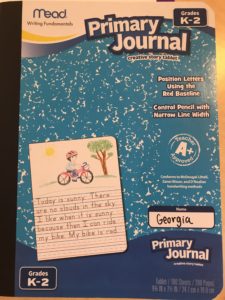
The inspiration for this practice comes straight from Roadmap to Literacy. (By the way, you can find more information about their approach at the site Waldorf Inspirations.) I can’t recommend this book highly enough!
The basic idea is that “kid writing” is different than “adult writing.” The hope is that using this term will help kids to know that there isn’t just one correct way to spell things. We want them to take risks and try writing whatever letters they hear. Usually they can come up with enough that they can read it back.
Day 1
So before our first kid writing session, I taught them the process. We worked with a sample together. The first topic we worked with was Summer.
- Draw a quick sketch of what you want to write about. The sketch is not a full drawing and should take no more than 3-5 minutes.
- Decide what you want to write and say the full sentence to yourself.
- Go through word-by-word.
- For each word, say it slowly and write the letters that you hear. (We did this with a sample sentence and I made sure to write a letter for each sound we heard, though I left off letters like silent e’s off. I had to be careful about which students I chose to offer letters, so we wouldn’t end up with a fully accurate sentence.)
- Pay attention to the first letter and the last letter. Usually you can hear those. (One of our sample words had the first letter and last letter, with a line in between.)
- If you know that there are more letters, but you don’t know what they are, write a magic line. The line is a way for you to notice that there are other sounds, even if you don’t know what they might be. (I went through an example, “Imagine you can hear that there is an ‘r’ at the beginning of “rain” but you’re not sure what else . . . “
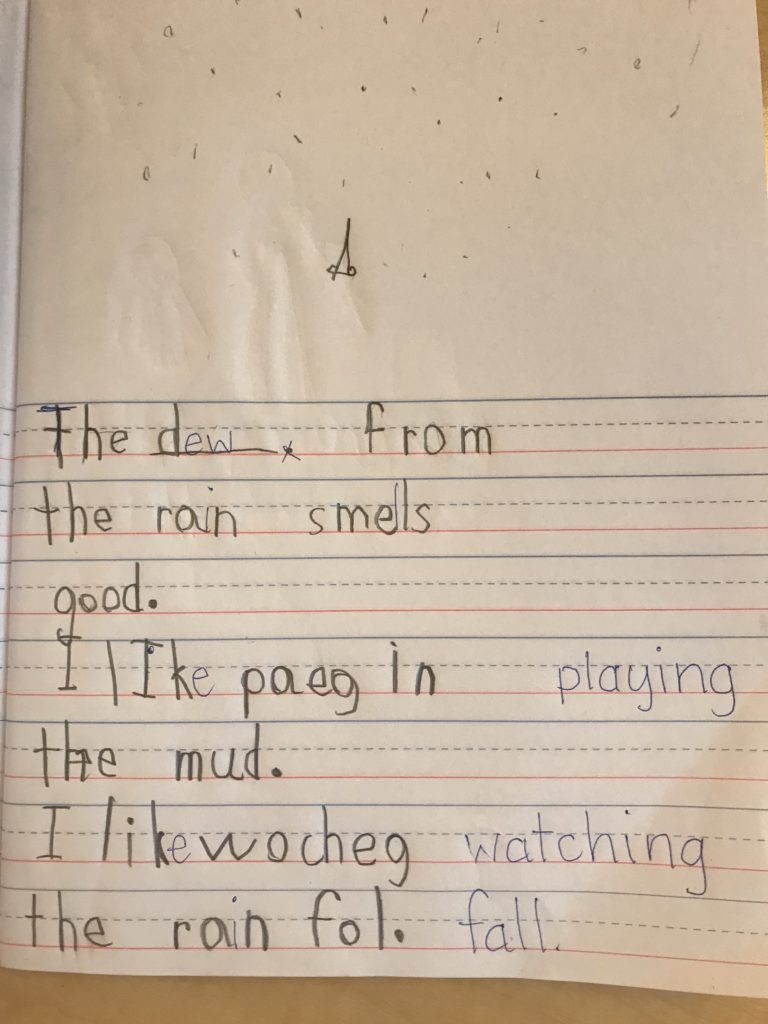
This is as far as the process goes on the first day. Most students finish their writing in about 15 minutes. My goal is that they’ll build up stamina and interest in their writing so they’ll go longer by the end of the year.
Day 2
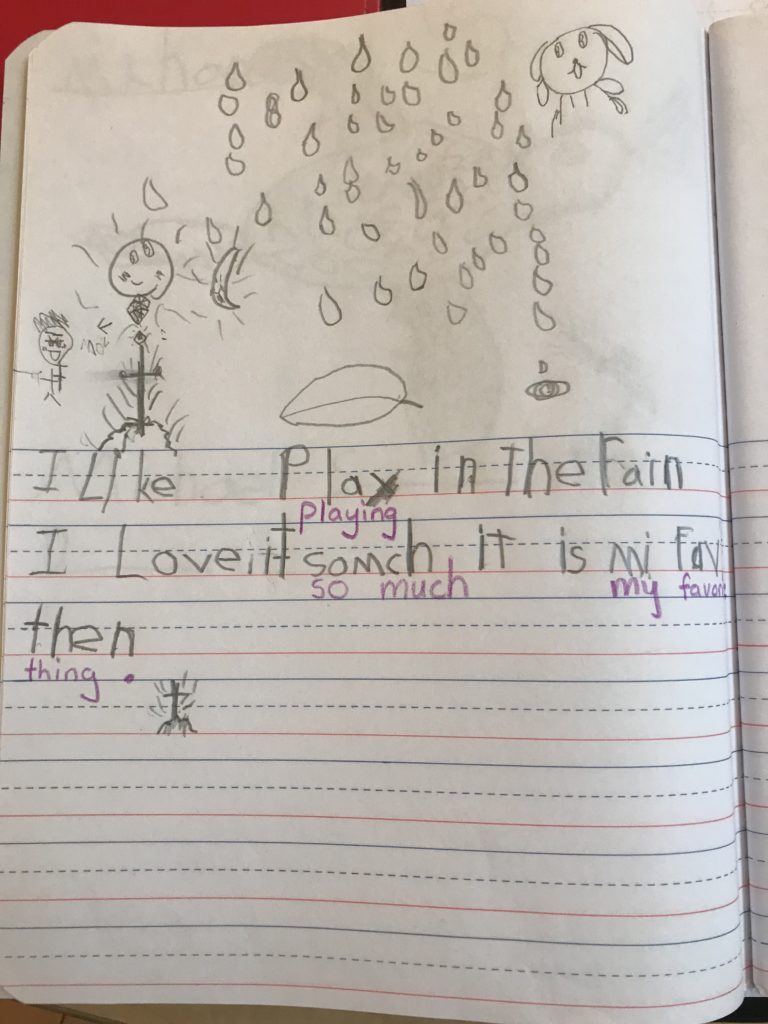
On the second day, students are finishing up their work and as they finish they come to either me or my support teacher and we go over their writing together. We look for opportunities to help them hear more letters in the words or to informally teach a rule that they’ll encounter again. For example, I’ve helped many of my students to hear the -ing that comes at the end of verbs. Seeing their writing also gives me a chance to craft future language arts lessons based on the mistakes that they’re making.
As we review their writing together, I write in the “adult writing.” My goal is that everyone has had their writing looked at by the end of day two.
Day 3
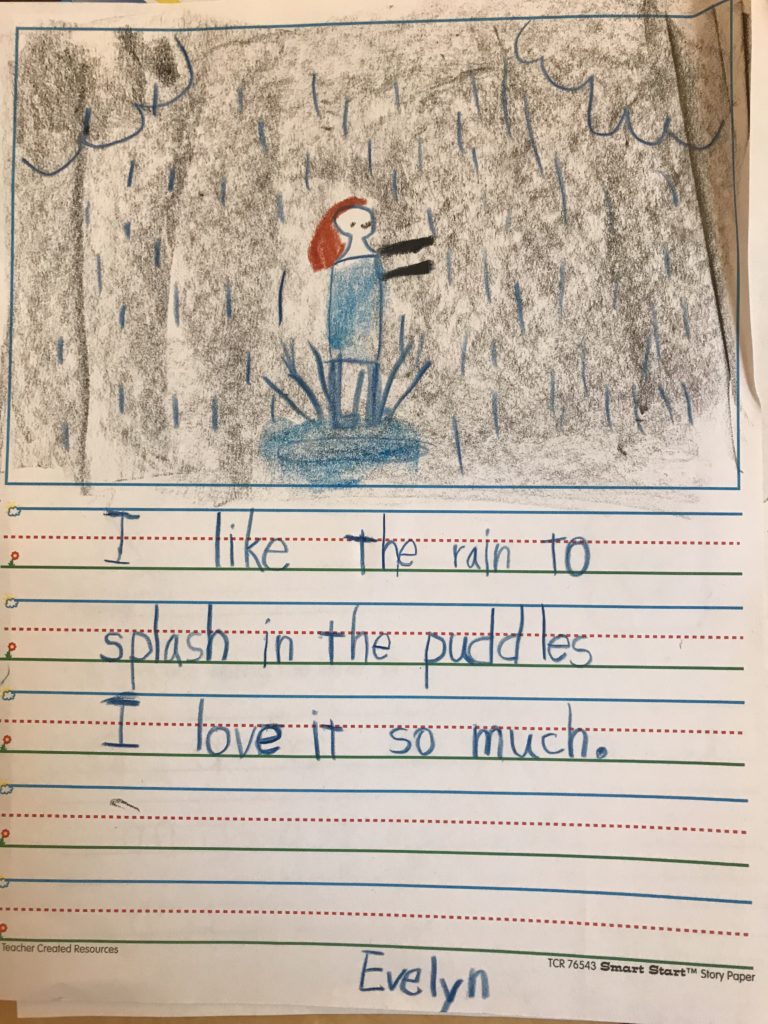
On the third day, they take their corrected writing and a nice piece of paper and do a polished drawing and rewrite their writing in finished form. My plan is to post these on the bulletin board in our classroom.
Supplies
To support the process, I gave them writing folders that are set up with a pocket on each side and brads in the center to hold papers that are 3-hole punched.
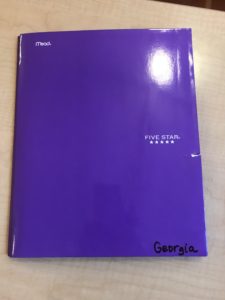
In the holes, I put a student dictionary that I bought and printed off of Teachers Pay Teachers.
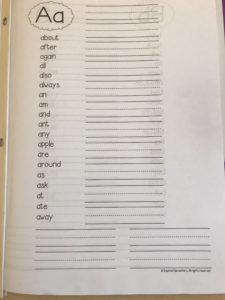
The students were so excited when I handed out their folders and they quickly looked through the words in their dictionaries. If I had it to do again, though, I would not give them those dictionaries right away. In our first kid writing lesson, they immediately turned to those dictionaries, searching for words that they wanted to write. They didn’t know enough about how to find the words they were looking for. And, truly, the value of kid writing is the process that they go through to sound out the words and write the letters that they hear.
At this point, now that we’ve done kid writing a few times, they are not turning to the dictionaries at all. I’ll probably bring their attention back to them later in the year and give a guided lesson on how to use them.
I’ve really been impressed with how much this writing is supporting their learning. At first many of my students were hesitant to take risks and write the letters they heard. They wanted to “get it right” and frequently asked me how to spell things. I responded by just saying the word slowly to encourage them to hear the letters and just nodded as they guessed letters. At this point they’re pretty independent with it. It helps that they know they can come to me with their finished writing and we’ll work through it together.
I’ll go through the other components of our language arts practice classes in another post (or two.)




Leave a Reply